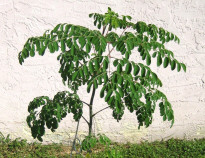How to Easily Sprout Moringa Seeds
There are many ways to sprout them - this is
what WE think, is the easiest way.
You can sprout them in just about anything, except for
clay-like soil, which they detest!
Moringa Seeds are NOT hard to sprout, but some folks seem to have a problem doing it. This method has worked for us, repeatedly. It is not necessary to do it this way, but it seems to work efficiently.
"Hi! I'm Morey, the Moringa Oleifera
Seed! My tree grows pods, that you can eat!"
REMINDERS ABOUT
MORINGA SEEDS
Many people
like to soak
seeds before
they plant them,
and you can
do that with
Moringa seeds,
but it is really not
necessary.
We have tried
sprouting seeds
both ways, and
see no advantage
to soaking them
first.
Should you decide
to do that, though,
just remember
to soak them in
warm water, not
cool or cold.
BE PREPARED!
If you put them in
a ziplock bag
with a bit of
water in it,
they will absolutely
REEK - the smell
is awful!
We found this method seems to "jump-start" the seeds, so you can enjoy
eating the bounty from your Moringa trees, fast!
They will sprout in regular potting soil, sandy soil, or water. As Moringa growers, however, we have found that they really love sprouting in coconut coir, which is shredded coconut husk, the best.
You will need:
You can purchase bricks of coconut coir from any large pet supply, as they are commonly used for reptile, amphibian, small animals, and insect bedding. One brick should be sufficient to sprout at least 20 Moringa seeds. The brick is made of densely compacted coconut fiber, which expands to about 4-5 times its size when water is added to it.
We usually "expand" the brick in a plastic dishpan, as it makes it very convenient to transfer the expanded, moist coconut fiber into the planting pots. This photo displays the compressed coconut fiber, also called coconut coir, brick, and the loose, fluffy results of adding water to it. Since the coconut coir is moist, you can plant your seeds right into it, without adding any more water.
Place a section of white paper towel in the bottom of your planting pot, to keep the coconut coir from falling through. Fill your planting pot up to about ¼ inch from the top, and poke a hole into the coconut coir. Drop your Moringa seed into the hole, and cover it up with more moist coconut coir. Place the pot either into direct sunlight, if the temperatures outside are over 70°F, or on a warm, sunny windowsill.
Every other day, thoroughly water your planting pot, and let it drain. Within 7-10 days, you should see a bright green seedling's head popping up above the coconut coir. You can let the seedling grow in the coconut coir for another week, and then we suggest transplanting into a mixture of ½ organic potting soil, and ½ coconut coir. That will give the seedling the nourishment it needs, for at least another month, when it can be transplanted into all potting soil, or into the ground.
Tips and Warnings:
* Moringas like the heat, so if you wish to grow them in a cool climate, plant them like an annual, when the weather is warm.
* Do not keep your seeds in the refrigerator, before you plant them. Room temperature keeps them viable. They will die, if put into refrigeration, for storage. Keep those seeds dry and warm, and they will sprout quite well for you.
* One word of caution, about your potting mixture - Moringas do not seem to like vermiculite - at all, so read the ingredients in your potting soil mix. Vermiculite and Moringas just do not co-habitate.
* Keep as much of the potting mixture around the roots of the Moringa seedlings when transplanting them, so they will not go into "shock"! Growing tropical Moringa trees is a lot of fun, and very rewarding. They grow very rapidly and will provide you with years of eating pleasure and they are lovely to behold!
I Love Moringa
the fast-growing, nutritious, delicious gift from God
This page was last updated: August 26, 2022
- Bricks of coconut coir
- Potting containers with good drainage holes
- A large container in which to mix the coir and water
- Water
- Warmth
- White paper towels
"We are tropical
seeds! We do not want to be stored in your freezer, your refrigerator,
or in any place where it is COLD!
We like to grow so much, that we
can even be planted as soon as you take us out of our pods.
Contrary to popular belief, we will try to grow, even if we are a few years old. Keep us warm, and we will be happy!"
HOW TO:
More About --- Moringa
